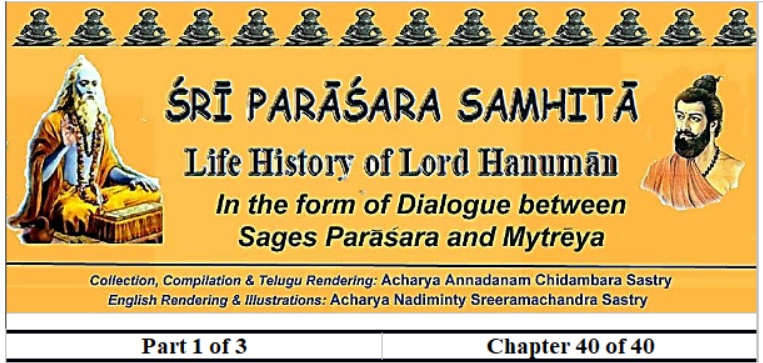
40th Chapter (Catvārinśatpaţalah) – Part 2
“The Story of Establishing the Hanumān Idol”
(Hanuma Dvigraha Pratşţhā Kathanam)
श्रीपराशर:
श्लोक :-
स्वगृह्रोक्तविधानेन षट्पात्रविधिनापि वा
चतुष्पात्रप्रयोगेन भूर्भुवस्स्वरोमिति।। 1
Parāśara:
Fire Sacrifice
“Oh! Mytrēya! As per the method of domestic rituals (gŗhyasūtravidhāna) or as per utilization of six vessels (şaţpātraprayōga) or as per utilization of four vessels (catuşpātraprayōga), with the ‘bhoorbhuvassuvarōm …’ (1)
मन्त्रेणाग्निं प्रतिष्ठाप्य दर्भपुष्पाक्षतैश्शुभै:
अग्निहोत्रमलंकृत्य कुर्याद्ध्यानादिकं मुने।। 2
Mantra, having established fire (agnipratişţhāpana) and having decorated the fire with auspicious dharba grass strands, flowers and auspicious rice grains, Oh! Maytrēya! Profound meditation (dhyānādhikam) has to be performed. (2)
अथाज्येन च व्याह्रद्रिर्जुहुयादाहुतीव्र्रती
आवातवाहीति ऋचा द्वादशा वृत्तिमात्रत:।। 3
Then, reciting the mantra ‘avātavāhi …’, the performer has to, with ghee, perform fire sacrifice (hōma) in twelve routines (āvŗuyyi). (3)
आहुतीर्मूलमंत्रेण जुहुयाद्गोघृतेन च
शम्यश्वत्थसमिद्दिश्च चरुणा गोघृतेन च
मधुसम्मिश्रितैव्र्रीहिपिष्टयुक्तैश्शुभैस्तिलै:।। 4
One has to submit cow ghee to the invited divine personalities, reciting the root (moola) mantra. With Indian fig (Ficus glomerata ) and Peepal (Ficus religiosa) twigs (dry wood splinters), rice oblation, honey and ghee mixed rice balls and sesame seeds, (4)
अष्टोत्तरसहस्रं वा अष्टोत्तरशतं च वा
आहुतीर्मूलमन्त्रेण जुहुयाच्छद्धयान्वित:।। 5
The invited divine personalities are to be worshipped 1008 or 108 times devotedly reciting thr root (moola) mantra. (5)
गाय या जुहुयादष्टविंशतिश्चरुणा तत:।। 6
Then, reciting the Gayatrī mantra twenty eight times, fire sacrifice has to be performed with rice. (6)
अथोपदेष्टा तन्त्रं च निर्वत्र्य विधिपूर्वकम्
अनन्तरं गयस्फानो मन्त्रेण चरुणा तत:।। 7
Then the instructor-preceptor should, after performing the procedure as stipulated, should perform the fire sacrifice twelve times with the mantra ‘gayasphanō …’ using rice, dry twigs, ghee and sesame seeds. (7)
हुनेत्स्वेष्टकृते विप्र यदस्येति च मन्त्रत:
समिधा ज्यतिलैश्चापि जुहुयाद्द्वादशाहुती:।। 8
Oh! Mytrēya! Reciting the mantra ‘yadsya karmaņō swāhā …’ one has to perform swişţakŗt (boon seeking) fire sacrifice with dry twigs, ghee and sesame seeds twelve times. (8)
संशोषिताज्येन हनुमद्विग्रहाड्गानि संस्पृशेत्
प्राणप्रतिष्ठासमये विग्रहा चार्ययोद्र्वयो:
नवीनेन च वस्त्रेण कुर्यादाच्छादनं प्रति।। 9
With the ghee left over after the fire sacrifice, all the body parts if the Hanumān deity have to be touched. During the prāņapratişţŗā (life-imparting) time, the performer (karta) haa to cover both the deity and the instructor-preceptor with new clothes. (9)
सुवर्चलायुतं हेमवर्णं पिंगाक्षमव्ययम्
आवाहयेद्धनूमन्तं विग्रर्हें कुशमुद्रया।। 10
(Hanumān), the One in the middle of the Sun’s disc of brilliance, the One riding a camel, the bright One, the spouse of with Suvarchala, One with golden body colour, One with pink eyes and the indistructable One has to be invited (āvāhana) into the idol with the elephant-goad (ańkuśa) hand gesture (mudra). (10)
देवस्य ह्र्दये ड्गुष्ठमाचार्यस्य विनिक्षिपेत्
जपेद्धनुमद्गायत्रीं अष्टाविंशतिसंख्यया।। 11
The preceptor, keeping his thumb against the heart region of deity of Lord Hanuman, recite the Hanumadgāyatrī (root for knowledge and devotion) mantra twenty eight times.(11)
सप्ताक्षरीं हनुमत: प्रजपेत्सूर्यसंख्यया
अनन्तरं मूलमंत्रं अष्टोत्तरशतं जपेत्।। 12
After reciting Hanumān Seven-Lettered (saptākşrī) mantra twelve times, the root (moola) has to be recited 108 times. (12)
प्राणप्रतिष्ठामन्त्रं च छन्दर्षिन्यासपूर्वकम्
त्रिवारमुच्चरेद्धीमानंगुष्ठं च विसर्जयेत्।। 13
Telling the meter (chandas), sage (ŗşi), nyāsa (body paer touching and hand gesticulation) and others, the prāņapratişţha (life-imparting) mantra thrice, the thumb has to be removed (from the deity). (13)
अस्य श्री प्राणप्रतिष्ठामहामन्त्रस्य विनियोग:।। 14
Sankalpa (Determibation) – Inviting Prāņaśaktī (Live Power)
‘Asysśrī prāņapratişţha (life-imparting) mantrasya brahma vişņu mahēśwarādyah ŗşayah, ŗg yaju ssāmā tharvaņā śchandāmsi, sakala chaitanyaswarūpiņī prāņaśaktih, paradēvatā, ām beejam, hreem śaktih, krōm keelakam, śrīhanuddēvarā prāņapratişţha siddhyarthē jape viniyōgah’ – so telling the intent (viniyōgah, here), performing the hand-heart and other nyāsa (touching and gesticulation), telling the digbandha (imaginary protective ring), then the following part of the mantra has to be recited thrice. (14)
ध्यानम्
रक्तभोधिस्थपोतोल्लसदरुणसरोजाधिरूढा कराब्जै:
पाशं कोदण्डमिक्षूद्रवमणिगणमप्यंकुशं पव्म्चबाणान्
बिभ्राणा सृक्कपालं त्रिनयनविलसत्पीनवक्षोरुहाढ्या
देवी बालार्कवर्णा भवतु सुखकरी प्राणशक्ति: परा न:।। 15
Entreaties for Life-Impartation
Dhyānam: Seated on a red lotus like a ship on the red sea; holding in hands a rope, a sugarcane bow, an elephant goad, five arrows and a blood-hued skull; resplendent with three eyes and prominent breasts; may the great life-power (prāņśakti) goddess with the hue of the raising sun provide us happiness. (15)
अस्मिन् हनुमद्विग्रहे प्राणप्रतिष्ठा हनुमत:
जीव इह स्थित आं ह्रीं क्रों यं रं लं शं षं
सं हं ळं क्षं हंसस्सा हं अस्मिन् विग्रहे प्राण इह पा्र ण:।। 16
May the life imparted stay here in this Lord Hanumān deity for the establishment of corporeal incarnation (life force; prāņaśaktih) of Lord Hanumān. May the life be imparted into this auspicious Hanumān deity, with this mantra – ‘Ōm krōm yam ram lam śam şam sam ham lam sam han-sō-ham‘ (16)
आं ह्रीं क्रों यं रं लं वं शं षं सं हं
ळं क्षं अस्मिन् श्री हनुमद्विग्रहे श्रोत्रत्वक्चक्षुर्जिह्वाघ्राणा:।।
अस्मिन् हनुमद्विग्रहे वाक्पाणिपादपायूपस्था:
अस्मिन् हनुमद्विग्रहे वचनादानगमनविसर्गानन्दा:
अस्मिन् हनुमद्विग्रहे मनोबुध्यहंकारचित्ता:
अस्मिन् हनुमद्विग्रहे प्राणापानव्यानोदानसमाना:
सर्वे इहैवागत्य सुखं चिरं तिष्ठन्तु स्वाहा।।
(क्रों ह्रींआं।। इमं मंत्रं त्रिवारं जपेत्) 17
May with this mantra – ‘Ām hreem kōm yam ram lam śam şam sam ham lam kşam‘ life get imparted into this auspicious Hanumān deity’s ears, skin, eyes, tongue and nose (sense organs). May life be imparted into the speech organs, hands, feet, penis and anus (action organs; karmēndriyāni) of this auspicious Hanumān deity. May life be imparted into the talk, action, movement, excretion, feeling happy (actions, i.e., function of concerned organs) of this auspicious Hanumān deity. May life be imparted into the soul-conciousness (man), intelligence (buddhi), ego (ahankār) and thought (citta) in this auspicious Hanumān deity. May the five vital airs or winds (vāyu) of the body, i.e., prāņa (life – respiratory), apāna (intestinal), vyāna (air circulating in the body), udāna (voice) and samāna (equivalising wind around navel) of this auspicious Hanumān deity always be in required levels eternally. Say three times the mantra ‘krōm hreem ām’. (17)
NOTE; Always pronounce ‘am’ as ‘u’ in the English word ‘but’ and ‘ām‘ as ‘a’ in the English word ‘balm’.
उद्घाट्याच्छादितं वस्त्रं विग्रहा चार्ययोरपि
उन्मीलनं विग्रहस्य चक्षुषा कारयेत्तथा।। 18
After that long ritual, the cloth covering the deity as well as the preceptor has to be removed and, then the (lids of the) eyes of the deity have to be opened (perhaps the last act of the concerned sculptor). (18)
वयस्सुपर्णमन्त्रेण विग्रहस्य प्रयत्नत:
संशेषिता ज्यं कुर्वीत वृष्टिं स्वर्णशलाकया।। 19
Reciting the ‘vayassuvarņā …’, mantra, the remaining ghee has to be dutifully sprinkled using a fine golden stick. (19)
आवाहनाद्यष्टमुद्रा विग्रहस्य प्रदर्शयेत्।। 20
Āvāhana and the Ritualistic Services
Then the āvāhana and other eight hand gesticulations (mudra) have to be exhibited to the deity. (20)
सूपापूपादिसंयुक्तं नानाफलसमन्वितम्
नैवेद्यं षड्रसोपेतं विग्रहस्य प्रदापयेत्।। 21
A food offering (naivēdya) has to be submitted to the deity, made of pulse, fried rice cakes and other edibles, with different types of fruits and having the six tastes (şadrasā),. (21)
तांबूलं मंत्रपुष्पं च वाद्यघोषं च कारयेत्
तथा वरणदेवानां नैवेद्यं च प्रदापयेत्।। 22
Betel leaves (tāmboola), sanctified flowers (mantrapuşpa) and soumd of musical instruments have to be arranged. Similarly, food offering (naivēdyame) has to be offered to the premises-ruling gods (āvaraņdēvatā). (22)
सम्यग्ध्यात्वा ततो देवं ब्राह्मणांश्च प्रपूजयेत्
वस्त्रैराभरणैर्दिव्यैर्गुरुं चापि प्रपूजयेत्।। 23
Then having meditated upon the Lord deeply, Brahmin people have to be worshipped. The preceptor has to be gifted with clothes and nice ornaments and worshipped. (23)
अथाष्टकलशानां तु मूलमन्त्रेण भक्तित:
वेदविद्भ्यश्च विप्रेभ्यो दानं कुर्याद्विचक्षण: 24
Then, reciting the root (moola) mantra, the eight vessels have to be worshipped fervently. (24)
रौप्येण वा सुवर्णेन हनुमद्विग्रहं तत:
कारयित्वा सुशीलाय ब्राह्मणाय प्रदापयेत्।। 25
Then, a Brahmin known for richness of good conduct (satśeela) has to be donated (dāna) with a Hanumān deity specially got made of gold or silver. (25)
हनुमत्प्रीतये कुर्यात् गोदानं सर्वकामदम्
अनन्तरं यथाशक्ति कुर्याद्ब्राह्मणभोजनम्।। 26
For satisfying Hanumān a bounty giving cow has to be donated. Then, a feast has to be arranged for Brahmin people as per one’s capacity. (26)
देवात्मानं स्वयं ध्यात्वा चिरं सुविहरेत्सुखी
देवो प्येवंकृते साक्षात् विग्रहे सुस्थिरो भवेत्।। 27
Final Acts of Establishing (Pratişţha)
By meditating on this Hanumān deity as desired god (işţadaiva) one can remain happy for ever. If this is done Lord Hanumān Himself will remain in the deity steadily for ever. (27)
हनुमत्पुरतो दिव्यमुष्ट्रं संस्थापयेद्विज:
पूजयेत्परमप्रीत्या संप्राप्नोति मनोरथान्।। 28
Whoever positions a camel (Hanumān‘s vehicle) in front of the deity and worships will have his wishes fulfilled. (28)
चक्रपाणिप्रतिष्ठायै कर्म निर्वत्र्य पूर्ववत्
अगुष्ठं चक्रमध्ये तु निक्षिप्य विधिपूर्वकम्
प्रजपेन्मन्त्रगायत्रीमष्टोत्तरशतं द्विज:।। 29
For life-impartation (prāņapratişţa) into a cakra (disc amulet), hold the disc by inserting the thumb into the centre of the disc, as stipulated and mentioned earlier, mantragāyatrī has to be recited 108 times. (29)
मंत्रराजाय विद्महे वरप्रदानाय धीमहि तन्नो मंत्र: प्रचोदयात्
सर्वदेवात्मं ध्यात्वा प्रधानं चेष्टदैवतम्
स्थापयेत्पीठमध्ये तु कृत्वा पूर्वदिशामुखम्।। 30
Having meditated as the desired deity (işţadaiva), mainly as the amalgamation of all gods (sarvadēvātmaka), keeping the face towards the East, the deity has to be establifhed in the center of the raised platform (manţapa). (30)
सर्वानितरदेवांश्च परिवारांश्च कारयेत्
कस्तूरिकाचन्दनादिसुगन्धद्रव्यचर्चित:।। 31
All other gods and goddesses have to be arranged as a family. Musk, sandalwood paste and other fragrant things to ajl invitees, (31)
कर्ता चोदड्मुखो भूत्वा संसिद्धो नियतेन्द्रिय:
परध्यानविहीनस्सन् पूजयेदिष्टदैवतम्।। 32
Sitting facing the North, the performer (karta), well-prepared, controlling senses and undistracted, has to worship the desired-god. (32)
पूजादौ श्रीहनूमन्तं पूजांते मुनिपुड्गव!
दिने दिने यथाशक्ति मूलमन्त्रं जपेत्सुधी:।। 33
Oh! Best of sages! A wise person should recite, as per his capacity, the root mantra, meditating upon Lord Hanumān, daily before and after worship. (33)
अन्यदैवं परित्यज्य एकं यद्दैवमेव य:
भजेच्च तस्माद्दैवाच्च सर्वमाप्नोत्यसंशय:।। 34
One undoubtedly achieves everything by worshipping Hanumān alone out of all the gods and goddesses. (34)
पूजार्थं श्रीहनूमत: मुने वक्ष्याम्यहं त्रूणु।। 35
Oh! Mytrēya! Listen. I am telling the method of performing Hanumān worship. (35)
ताम्रेण रजतेनैव सुवर्णेन विशेषत:
कुर्यात्पात्रद्वये दिव्यमुपचारांश्च विंशति:।। 36
Hanumān Worship
With copper or silver or especially gold get two main divine vessels made. Twenty services are to be performed, (36)
पूर्णं च विनियोगं च पात्रद्वयमुदाह्मतम्
पूर्णपात्रस्थमुदकं विनियोगे विनिक्षिपेत्।। 37
The two are tokd as the full vessel (poorņa patra) and utility vessel (viniyōga patra). Water from the full vessel is to be poured into the utility vessel, (37)
सप्तवर्णमनुं विप्र उच्चरेच्रिहन्नूमत:
कारयेच्च प्रतिदिनं उपचारांश्च विंशति:।। 38
Oh! Best one amongst the Brāhmins! The Seven Lettered (saptākşrī) mantra of Hanumān has to be recited. Twenty service are to be oerfirmed everyday. (38)
आवाहनासनं पाद्यमघ्र्यमाचमनीयकम्
स्नानं वस्त्रोपवीतं च गन्धपुष्पाक्षतादय:।। 39
Āvāhana (invitation), āsana (seating), pādya (water for drinking), arghya (water for feet washing), ācamana (thrice sipping of water from palm), snāna (bath), vastra (cloth), yagńyōpavīta (sacred thread), gandha (sandalwood paste), puşpa (flower), akşatāni (auspicious yellowed rice), (39)
धूपं दीपं च नैवेद्यं पानीयं तदनन्तरम्
ताम्बूलं मन्त्रपुष्पं च नृत्यं गीतं तथैव च
प्रदक्षिणनमस्कारौ उपचारांश्च विंशति:।। 40
Dhoopam (incense), deepam (lamp), naivēdyam (sacred foos offering), paneeyam (drink), tāmboolam (betel leaves with arica nut), mantrapuşpam (ausoicious flower with coins), nŗutyam (dance), geetam (song) and pradakşiņa namaskāra (bowing with folded hands thric as one goes around at the same place) are known as the 20 services (upacārās), (40)
पिपीलिकामक्षिकादिस्पृष्टं यद्दृढबीजकम्
मृच्छिला केशदुष्टंच यदप्यशुचिपाचितम्।। 41
Touched by ants, domestic flys and others, over ripe ones, bad things that got mixed with soil, pebbles and human hair, unhygienic in any manner, those already offered as penance (prāyaścitta), (41)
अतिपक्वमपक्वं च तद्विहाय सुपावनम्
नैवेद्यं दीयते तुभ्यं हनुमन् प्रतिगृह्नतां।। 42
Over-coocked or under-coocked ones are to be left out; and only the most sacred food (pavitra) is being offered (naivēdyam) to you by me. Oh! Lord Hanumān! Kindly accept. (42)
प्रतीक्षंते सुरास्सर्वे धूपस्यावसरं यत:
तेन तुष्टो भवश्रीमन्नांजनेय नमो स्तु ते।। 43
Oh! Āńjanēya! The gods are waiting for the time of offering dhoopa to you. Hence, Oh! Lord (Swamī)! Please be satisfied with my this worship (ārādhana). I bow to Thee. (43)
एलागुग्गुलसंयुक्तगव्याज्येन सुसम्प्लुत:
धूपो यं गृह्नतां देव! आव्म्जनेय नमो स्तु ते।। 44
Accept this dhoopam made of cardamom, guggula (fragrant balsom) and cow ghee.Oh! God! Āńjanēya! I bow to Thee’. (44)
एवं य: पूजयेन्नित्यं प्रतिष्ठितमतन्द्रित:
इह भुक्त्वा खिलान्भोगानन्ते मुक्तिं स विन्दति।। 45
Whoever worships thus established Hanumān, daily without any hesitation, will enjoy all desires in this mundane worls and achieves salvation after demise. (45)
हनूमदालयं गत्वा तत्पदासक्तमानस:
सप्ताक्षरीं हनुमतो दशवारं जपेत्सुधी:।। 46
A wise person, on going to a Hanumān temple, has to concentrate mind on the feet of Lord Hanumān and recite the saptākşrī mantra of Hanumān ten times. (46)
इति श्रीपराशरसंहितायां श्रीपराशरमैत्रेयसंवादे श्रीहनुमद्विग्रहप्रतिष्ठाकथनं नाम चत्वारिंशत्पटल:
Thus ends the 40th Chapter (Ēkōnacatvārinśatpaţalah) – Part 2 “The Story of Establishing the Hanumān Idol” (Hanumadvigraha pratşţhā kathanam) of Śrī Parāśara Samhitā
![]()

Click here to visit the Contents of the Part 1.
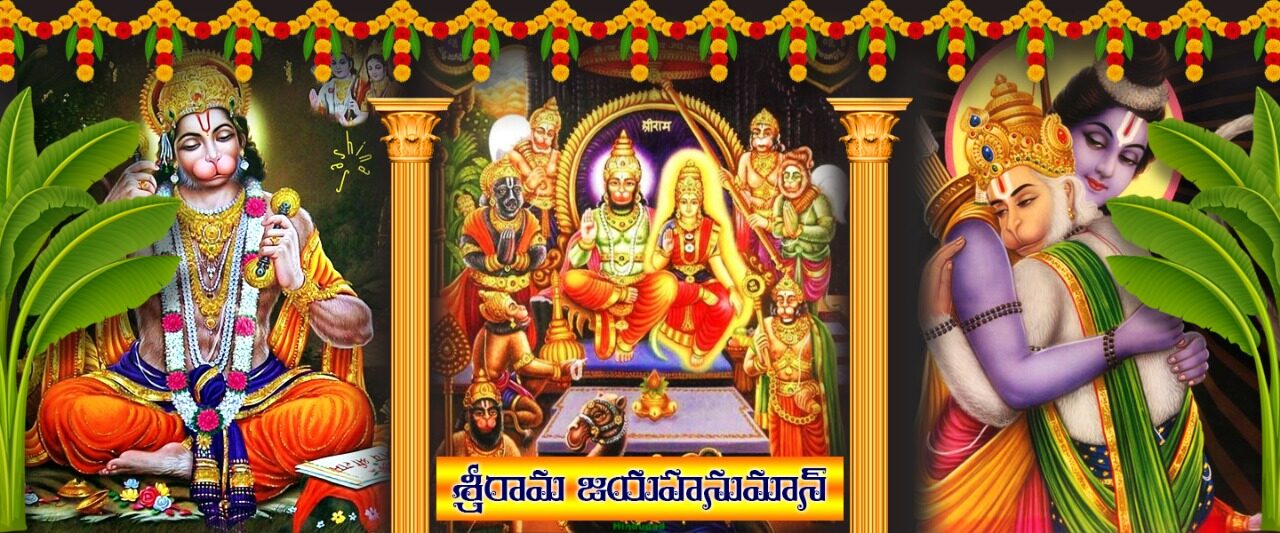
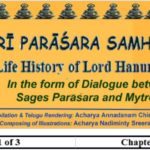


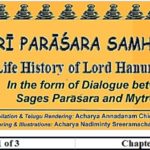


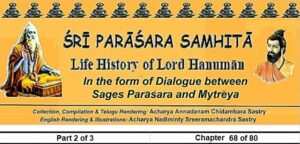
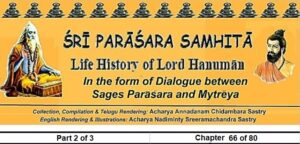
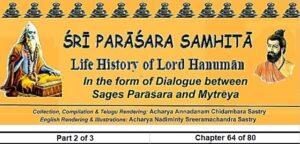
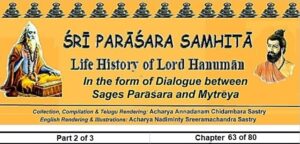
Be First to Comment